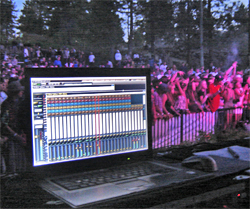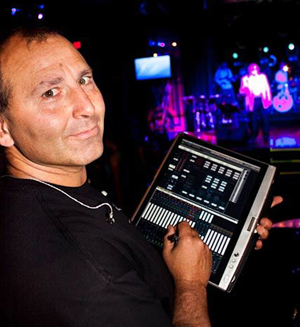
What’s more, none of the virtual consoles interact, in any way, with other virtual consoles, except to share the same head-amps.
It would be entirely feasible to have 24 separate operators – each concentrating on a single monitor mix – if that’s what’s needed for a given situation.
The same scenario can be used for other applications as well, such as when many different zones require different balances.
Consider a complex AV system that encompasses numerous rooms, or even numerous geographic locations. Each location might have sources that are both local and remote. In this scenario, all virtual consoles would share all inputs from all locations (or just accept stems, if that’s preferred). The individual location engineers can then balance the global inputs (or stems) against their individual local sources, thereby providing the appropriate mix for the room they’re serving.
While this is a concept that could be executed with conventional hardware, the complexity and cost would be prohibitive for all but the most exalted events, bearing the highest possible budgets, and unlikely to happen except in the most rarefied of circumstances.
A recent medical conference, taking place in several countries simultaneously, did exactly that. Orchestrated by Lee Pepper, who could accurately be called a super-user of Lentini’s original Software Audio Console, the convention included real-time surgery performed on live patients in numerous locations at the same time. SAC provided the ability for the attending doctors to interact with one another, via Internet connectivity, during these mission critical procedures. It’s a brave new world.
Freedom To Move
Though there’s no requirement that an AIR console be controlled by a wireless tablet or wireless laptop, (you can always use an Ethernet cable, if you like), it can be highly advantageous to do so. The ability to roam freely throughout a venue and tweak zone levels and zone EQ on each of the 72 outputs, gives the engineer a whole new palette of capabilities. For the first time, he/she will really know what’s going on throughout the venue during the show, instead of having to rely on comments from others.
Freeing up valuable seating space is another attribute, and one that’s bound to make promoters happy. Not only is it possible to reclaim seating space taken up by the console itself, but eliminating the security barriers and security guards that are normally needed to surround the house mix position, can represent a significant cost savings.
An AIR console footprint is insanely small: two shoes walking. And because audio never passes though the laptop or tablet, the remote devices merely communicate control signals. Therefore, a failure in the wireless link will not bring the system down – it will always remain where it was last set.
And in lieu of tablets and laptops, AIR makes various sizes of touch screens available – up to 32 feet – for those who wish for more tactile control, or who may not benefit from the ability to move throughout the venue. Shows such those that take place in TV studios, or a theatrical environment, are two of many such examples.
One comment that came up repeatedly while researching this article: performing artists absolutely love having their monitor engineer walk on stage and stand next to them, tablet in hand, to adjust the stage monitors to their individual taste and satisfaction.
And from the monitor engineer’s perspective, he/she can finally hear and experience exactly what the artist herself is experiencing. As hard as you try, second guessing the effect of a Marshall Stack behind the guitar player, is a guess at best. Hand signals are no longer needed, so sound checks move along faster and with far better results.
While cabling is still required to connect microphones to the head amps, which typically will be located at the side of the stage adjacent to the monitor engineer (if a monitor engineer is present), there is no longer a need for expensive splitters and multi-core cabling. This aspect alone saves hundreds of hours of labor over the course of a tour; reduces the size of truck space (or even the size of the truck itself); and eliminates tens of thousands of dollars of rental or purchase expense.

